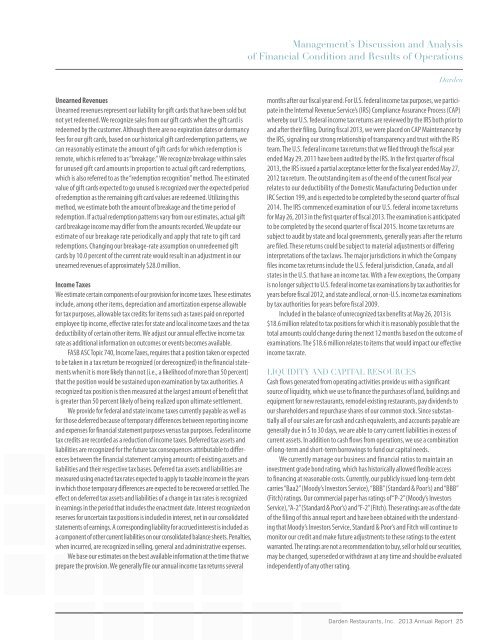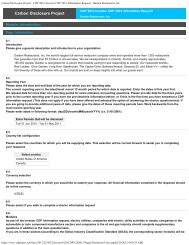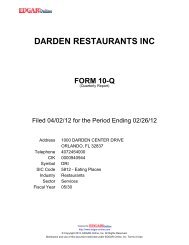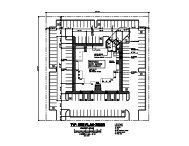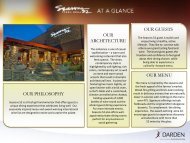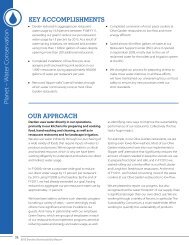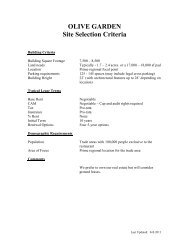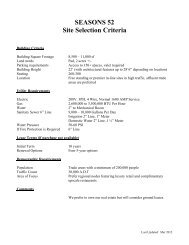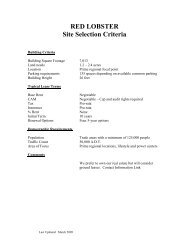2013 Annual Report - Investor Relations - Darden Restaurants
2013 Annual Report - Investor Relations - Darden Restaurants
2013 Annual Report - Investor Relations - Darden Restaurants
Create successful ePaper yourself
Turn your PDF publications into a flip-book with our unique Google optimized e-Paper software.
Management’s Discussion and Analysisof Financial Condition and Results of Operations<strong>Darden</strong>Unearned RevenuesUnearned revenues represent our liability for gift cards that have been sold butnot yet redeemed. We recognize sales from our gift cards when the gift card isredeemed by the customer. Although there are no expiration dates or dormancyfees for our gift cards, based on our historical gift card redemption patterns, wecan reasonably estimate the amount of gift cards for which redemption isremote, which is referred to as “breakage.” We recognize breakage within salesfor unused gift card amounts in proportion to actual gift card redemptions,which is also referred to as the “redemption recognition” method. The estimatedvalue of gift cards expected to go unused is recognized over the expected periodof redemption as the remaining gift card values are redeemed. Utilizing thismethod, we estimate both the amount of breakage and the time period ofredemption. If actual redemption patterns vary from our estimates, actual giftcard breakage income may differ from the amounts recorded. We update ourestimate of our breakage rate periodically and apply that rate to gift cardredemptions. Changing our breakage-rate assumption on unredeemed giftcards by 10.0 percent of the current rate would result in an adjustment in ourunearned revenues of approximately $28.0 million.Income TaxesWe estimate certain components of our provision for income taxes. These estimatesinclude, among other items, depreciation and amortization expense allowablefor tax purposes, allowable tax credits for items such as taxes paid on reportedemployee tip income, effective rates for state and local income taxes and the taxdeductibility of certain other items. We adjust our annual effective income taxrate as additional information on outcomes or events becomes available.FASB ASC Topic 740, Income Taxes, requires that a position taken or expectedto be taken in a tax return be recognized (or derecognized) in the financial statementswhen it is more likely than not (i.e., a likelihood of more than 50 percent)that the position would be sustained upon examination by tax authorities. Arecognized tax position is then measured at the largest amount of benefit thatis greater than 50 percent likely of being realized upon ultimate settlement.We provide for federal and state income taxes currently payable as well asfor those deferred because of temporary differences between reporting incomeand expenses for financial statement purposes versus tax purposes. Federal incometax credits are recorded as a reduction of income taxes. Deferred tax assets andliabilities are recognized for the future tax consequences attributable to differencesbetween the financial statement carrying amounts of existing assets andliabilities and their respective tax bases. Deferred tax assets and liabilities aremeasured using enacted tax rates expected to apply to taxable income in the yearsin which those temporary differences are expected to be recovered or settled. Theeffect on deferred tax assets and liabilities of a change in tax rates is recognizedin earnings in the period that includes the enactment date. Interest recognized onreserves for uncertain tax positions is included in interest, net in our consolidatedstatements of earnings. A corresponding liability for accrued interest is included asa component of other current liabilities on our consolidated balance sheets. Penalties,when incurred, are recognized in selling, general and administrative expenses.We base our estimates on the best available information at the time that weprepare the provision. We generally file our annual income tax returns severalmonths after our fiscal year end. For U.S. federal income tax purposes, we participatein the Internal Revenue Service’s (IRS) Compliance Assurance Process (CAP)whereby our U.S. federal income tax returns are reviewed by the IRS both prior toand after their filing. During fiscal <strong>2013</strong>, we were placed on CAP Maintenance bythe IRS, signaling our strong relationship of transparency and trust with the IRSteam. The U.S. federal income tax returns that we filed through the fiscal yearended May 29, 2011 have been audited by the IRS. In the first quarter of fiscal<strong>2013</strong>, the IRS issued a partial acceptance letter for the fiscal year ended May 27,2012 tax return. The outstanding item as of the end of the current fiscal yearrelates to our deductibility of the Domestic Manufacturing Deduction underIRC Section 199, and is expected to be completed by the second quarter of fiscal2014. The IRS commenced examination of our U.S. federal income tax returnsfor May 26, <strong>2013</strong> in the first quarter of fiscal <strong>2013</strong>. The examination is anticipatedto be completed by the second quarter of fiscal 2015. Income tax returns aresubject to audit by state and local governments, generally years after the returnsare filed. These returns could be subject to material adjustments or differinginterpretations of the tax laws. The major jurisdictions in which the Companyfiles income tax returns include the U.S. federal jurisdiction, Canada, and allstates in the U.S. that have an income tax. With a few exceptions, the Companyis no longer subject to U.S. federal income tax examinations by tax authorities foryears before fiscal 2012, and state and local, or non-U.S. income tax examinationsby tax authorities for years before fiscal 2009.Included in the balance of unrecognized tax benefits at May 26, <strong>2013</strong> is$18.6 million related to tax positions for which it is reasonably possible that thetotal amounts could change during the next 12 months based on the outcome ofexaminations. The $18.6 million relates to items that would impact our effectiveincome tax rate.LIQUIDITY AND CAPITAL RESOURCESCash flows generated from operating activities provide us with a significantsource of liquidity, which we use to finance the purchases of land, buildings andequipment for new restaurants, remodel existing restaurants, pay dividends toour shareholders and repurchase shares of our common stock. Since substantiallyall of our sales are for cash and cash equivalents, and accounts payable aregenerally due in 5 to 30 days, we are able to carry current liabilities in excess ofcurrent assets. In addition to cash flows from operations, we use a combinationof long-term and short-term borrowings to fund our capital needs.We currently manage our business and financial ratios to maintain aninvestment grade bond rating, which has historically allowed flexible accessto financing at reasonable costs. Currently, our publicly issued long-term debtcarries “Baa2” (Moody’s <strong>Investor</strong>s Service), “BBB” (Standard & Poor’s) and “BBB”(Fitch) ratings. Our commercial paper has ratings of “P-2” (Moody’s <strong>Investor</strong>sService), “A-2” (Standard & Poor’s) and “F-2” (Fitch). These ratings are as of the dateof the filing of this annual report and have been obtained with the understandingthat Moody’s <strong>Investor</strong>s Service, Standard & Poor’s and Fitch will continue tomonitor our credit and make future adjustments to these ratings to the extentwarranted. The ratings are not a recommendation to buy, sell or hold our securities,may be changed, superseded or withdrawn at any time and should be evaluatedindependently of any other rating.<strong>Darden</strong> <strong>Restaurants</strong>, Inc. <strong>2013</strong> <strong>Annual</strong> <strong>Report</strong> 25


